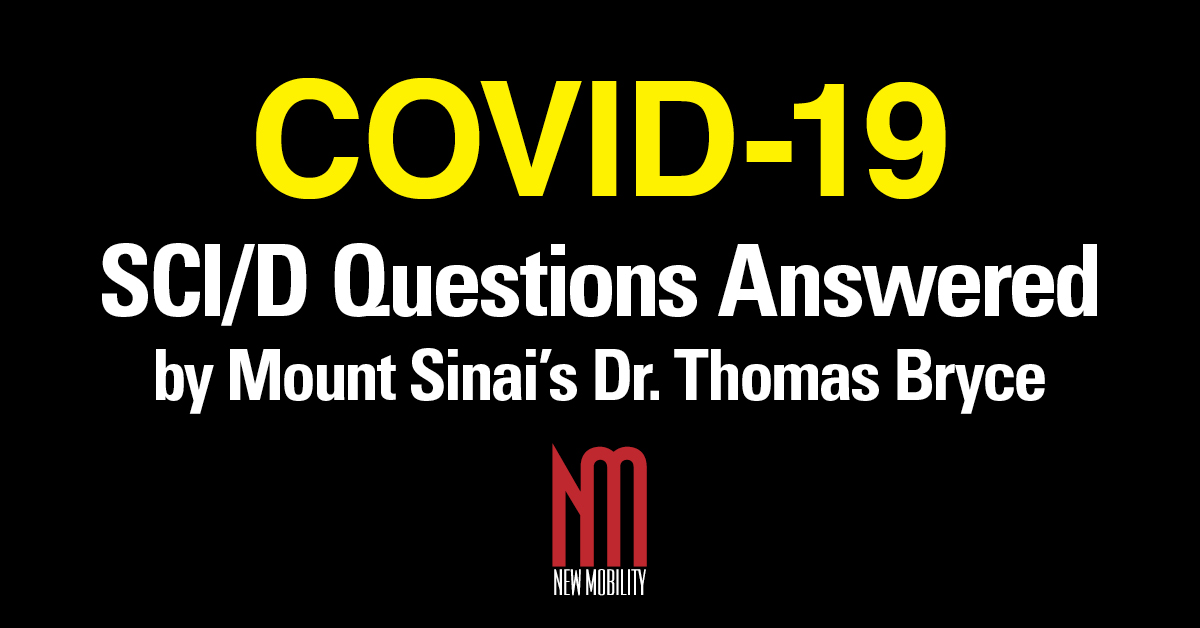As part of our continuing coverage on COVID-19 and SCI/D, New Mobility Editor Ian Ruder emailed Dr. Thomas Bryce, the medical director of Mount Sinai’s Spinal Cord Injury Program, to get answers to some of the more frequently asked questions in the SCI/D community.
Ian Ruder: Does the isolated diagnosis of SCI/D in an otherwise healthy individual put them at increased risk of contracting COVID-19?
Dr. Thomas Bryce: An isolated diagnosis of SCI/D in an otherwise healthy individual may put the individual at increased risk, depending on the cause of the SCI/D. If someone acquired SCI/D through transverse myelitis, Guillain-Barré syndrome, or spinal cord compression from cancer, they may have an impaired immune system and be at greater risk.
If someone is self-isolating and requires a personal care assistant who does not live with them, they may be at increased risk of contracting COVID-19 from the personal care assistant.
IR: Does the isolated diagnosis of SCI/D in an otherwise healthy individual put them at increased risk of developing severe symptoms if they contract COVID-19?
TB: An isolated diagnosis of SCI/D in an otherwise healthy individual may put the individual at increased risk, depending on the cause of the SCI/D. If someone acquired SCI/D through transverse myelitis, Guillain-Barré syndrome, or spinal cord compression from cancer, they may have an impaired immune system and be at greater risk of developing severe symptoms.
The other known risk factors thought to increase the risk of developing severe symptoms include age over 65, high blood pressure, chronic kidney disease, chronic lung disease such as emphysema or asthma, diabetes — especially if not well controlled — pregnancy, and being on immunosuppressant medications.
IR: Does SCI/D-related impaired respiratory function put someone at higher risk with COVID-19 even if they aren’t otherwise immunocompromised? If so, what injury levels causes more concern?
TB: SCI/D-related impaired respiratory function puts someone at higher risk with COVID-19 even if they aren’t otherwise immunocompromised. Persons with all levels of SCI/D above T12 have a reduced ability to both inspire air maximally and to forcefully expel air through coughing.
The higher an injury level is, the greater the impairment of respiratory function will be, with persons with cervical and upper thoracic levels of injury having greater impairments than those with lower thoracic levels of injury.
With COVID-19, the tiny air sacs in the lungs that absorb oxygen can fill with fluid, preventing oxygen from being absorbed. Persons with SCI/D above T12 have less reserve lung capacity, meaning that when parts of the lung are not working to absorb oxygen, other areas are not able to take over and compensate for the loss.
With an impaired cough, individuals are less able to expel secretions that fill the airways and air sacs, further preventing oxygen from being absorbed. The higher the injury level is, the weaker the cough. Persons with cervical and upper thoracic levels of injury have weaker coughs than those with lower thoracic levels of injury.
IR: At what point of showing COVID-19 symptoms should someone with SCI/D go to the ER?
TB: As COVID-19 can progress very fast, with a person breathing with mild shortness of breath one minute, then being unable to breathe and in respiratory failure several minutes later. Persons who are at greater risk of developing severe symptoms, especially persons with upper thoracic and cervical levels of SCI/D, should go to the hospital if they are experiencing any shortness of breath. Hospitals should have a lower threshold for admitting persons with SCI/D-related impaired respiratory function than for persons without such impaired respiratory function.
IR: What is the latest thinking about how long COVID-19 lives on surfaces? And how long it lingers in the air?
TB: The COVID-19 virus can only replicate in the cells of a living organism such as a person. The virus spreads primarily through respiratory secretions and droplets that exit the mouth or nose when an infected person coughs or sneezes or even breathes out. How long the virus survives outside the body depends on a number of factors, including the quantity of respiratory secretions surrounding it.
The size of a droplet also impacts how long it lingers in the air. Heavy droplets will generally fall to the ground soon after exiting the mouth or nose, depending on how forcefully they are expelled, typically within 3 to 4 feet. Lighter droplets may remain suspended in the air for longer periods, just as smoke may linger in the air for several minutes. Aerosolized droplets can remain infectious for hours, as demonstrated in laboratory settings.
Once droplets land on surfaces, they remain infectious for differing amounts of time, depending on the surface. In laboratory experiments, COVID-19 virus remained viable and infectious on cardboard for up to 24 hours, while it remained infectious for up to 72 hours on plastic and stainless steel. Environmental factors also impact how long the virus survives outside the body. For instance, UV rays from the sun can hasten inactivation of the virus.
** This post was originally published on https://www.newmobility.com/2020/03/faqs-about-covid-19-and-sci-d/


